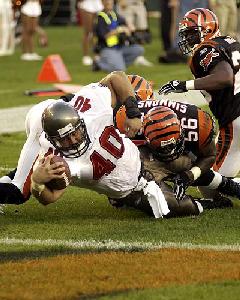|
|
 |
 Roy Cummings, The Tampa Tribune, published 30 September 2002
Roy Cummings, The Tampa Tribune, published 30 September 2002
Letdown? The only Bucs letdown anyone at Paul Brown Stadium witnessed Sunday was the Bucs' offense letting its hair down. Though it still has a tendency to be as conservative as Pat Buchanan, there were times during its 35-7 pasting of the Bengals when the Bucs' offense looked downright uninhibited. You wanted downfield passing? You got downfield passing.
Long after quarterback Brad Johnson dropped 35- and 65- yard touchdown bombs to spark the rout midway through the second quarter, the Bucs continued throwing and throwing deep. ``We definitely took some shots today,'' Bucs coach Jon Gruden said. ``I mean, we saw a team today that was content on applying a lot of pressure, running a lot of blitzes. And that's usually how it is when you play a team that blitzes a lot. You're going to make some plays. The big thing is, we saw a different kind of defense today.''
So did the Bengals. A year after it allowed Cincinnati to hang around before pulling out a 16-13 overtime win, Tampa Bay came out firing, limiting the Bengals to just 168 total yards and no offensive scores. ``It was a challenge for us today,'' defensive tackle Warren Sapp said. ``We came up here a year ago and this team was putting on 15-play drives as soon as we took the field. So we were determined not let any of that happen today.''
The Bengals' only points came on a 51-yard Brian Simmons interception return. But even with that, the Bucs completed the stingiest three-game stretch in their history. In the last three games, the Bucs have allowed just 21 points. Tampa Bay had never held three consecutive opponents to so few points. Something else the Bucs have never done is shut out two opposing offenses in back- to-back road games. They completed that task Sunday, two weeks after winning 25-0 at Baltimore, but that may have had something to do with their opponent.
``We were actually picking up on what they were doing and we still didn't have any success out there,'' said Bengals quarterback Akili Smith, who completed 12 of 33 passes for 117 yards. ``They were calling out the blitzes that we saw on film, so we knew what they were doing. But we still didn't have any success.''
The Bengals weren't the only ones who quickly caught on to what their opponents were doing defensively. The Bucs did likewise, but found a way to attack it. By calling for an array of blitzes, the Bengals were leaving open the deep middle of the field, where the tight ends and an occasional receiver were left in single coverage against a safety. The Bucs first tried to attack that area in their third offensive series, when Johnson threw deep but just beyond the grasp of a wide open Rickey Dudley, who was streaking alone down the numbers on the left side of the field.
One series later, after Simmons had given the Bengals their first lead of the season with his TD return, Johnson connected with a lonesome Dudley on a similar pass play, this one resulting in a 35-yard touchdown. ``They were playing a single safety in the middle of the field and any time you get that, you are going to have some chances to get open,'' Dudley said. ``The chance was there for me and we took advantage of them.''
Those kinds of chances were still there later in the second quarter, when Keenan McCardell took off downfield after completing a simple curl pattern along the left sideline. When three defenders converged on Keyshawn Johnson, who was running a hook pattern, McCardell was left alone. Despite being hit just as he released the ball, Brad Johnson connected with McCardell in stride on a 65-yard scoring play that was the longest the Bucs have had since Trent Dilfer connected with Reidel Anthony on a 79-yarder on Nov. 15, 1998 against Jacksonville. ``Those types of things usually don't happen,'' said Brad Johnson, who threw for 277 yards and three touchdowns, the last of which was a 22-yarder to tight end Ken Dilger. ``But when the throws are there downfield, we're going to take them. That's what we did today.''
And that's what they had to do. As has been the case most of the year, the running game was not up to the necessary standards. Though they got a 17-yard run out of Michael Pittman and 14-yard runs out of Aaron Stecker and Mike Alstott, the Bucs averaged just 3.6 yards per carry and lost one fumble. Tampa Bay's pass protection also struggled at times. Much of that can be attributed to the vast array of blitzes the Bengals came with and the fact they started a left guard (Kerry Jenkins) nursing a cracked fibula and a backup right tackle, Cornell Green. No matter, there is room for improvement. ``There are some things we can do better, to give Brad better protection,'' Gruden said. ``But at times we protected very well and gave Brad a chance to make some big plays.''
|

|
|
| |
| |
|